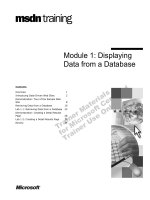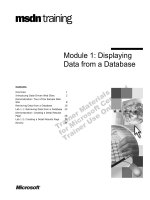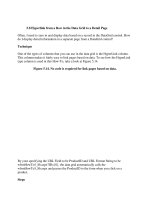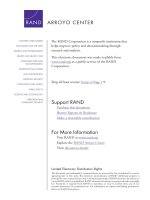Data monetization lessons from a retailer s journey
Bạn đang xem bản rút gọn của tài liệu. Xem và tải ngay bản đầy đủ của tài liệu tại đây (308.27 KB, 9 trang )
Data Monetization: Lessons from a
Retailer’s Journey
A company that has the data and the know-how to use
the data properly will have an advantage in the era of big
data. If both capabilities are low then the company has
three potential pathways to transition to the high
capabilities that will enable it to monetize its data:
Source: M. Najjar, W. Kettinger
Pathway 1: Move Direct to Higher Risk and High
Reward
To follow this pathway, companies need to invest in
developing their technical infrastructure while hiring and
training employees with the required business,
mathematical and analytical skills.
While costly following this pathway will quickly position a
company to be ready for monetizing its data and
collaborating with supply-chain partners.
Pathway 2: Build Analytical Capability First
Following this pathway, a company chooses to develop its
analytical capability first. This hiring requires training
employees and/or hiring business analysts with the
required set of business, mathematical and analytical
skills. As its analytical capability grows, the company may
leverage them by generating more data or buying data.
Pathway 3: Build Technical Data
Infrastructure First
Instead of first developing its own analytical capability a
company may choose to extend or outsource its technical
data infrastructure to produce an attractive collection of
data that can be sold to suppliers.
By building a platform that will enable it to market its
saleable data, a company can more quickly monetize its
data.
DrugCo’s Four-Stage Data Monetization
Journey
The case of "DrugCo" a U.S.-based Fortune 500 drug
retailer with several thousand stores in more than half of
U.S. states, illustrates a company that has followed
Pathway 3. Let's dive right in:
Stage 1: Building Bl&A Capabilities
DrugCo improved its in-house technical data capability by
developing a data warehouse and using basic data
analytical tools (e.g., Microsoft Access and Excel)
The data exploitation costs in this stage were the technical
cost of building the data warehouse and connecting it to
the reporting tools, and the analytical cost of analyzing
the data.
Stage 2: Connecting to and Sharing
Information with Suppliers
In Stage 2. DrugCo created a secure, cloud-based portal
for communicating with its suppliers. The portal provided
access to point-of-sale, customer-loyalty, and
transactional data and various BI&A applications.
As an analytical data warehouse platform, it allowed
suppliers to work with and analyze DrugCo's data so the
company and suppliers could collaborate on mutual
business goals.
Stage 4: Further Monetizing Data and
Avoiding Analytical Costs by Leveraging
Suppliers’ Resources
In Stage 4 collaboration with DrugCo and increased their
sales: for example, they could use a shelf-monitor
program that looks at sales of their products and detects
a potential out-of-stock, which may cause a consumer to
switch and buy a competitor's product. Some suppliers
became trusted sources of data analysis.
Based on these analyses, suppliers developed
merchandising strategies and targeted promotional
programs that DrugCo could implement.
Lessons Learned
❏ Consider How Creating and Sharing Data Will Change
Relationships and Business Models
❏ Identify Where You Currently Are in the Data
Monetization Journey and Where You Want to End Up
❏ Develop Contracts to Ensure Adherence to Data
Monetization Policies
❏ Nurture Trust Between the Involved Parties









